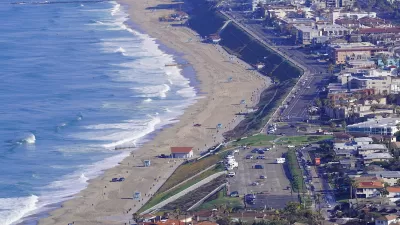Torrance, a city on the coast of Southern California in the Los Angeles metropolitan area, recently adopted a zoning overlay that will relax commercial zones to allow more residential development.

The city of Torrance will allow residential developments in commercial zones, after the City Council recently approved a housing overlay zone to that effect.
According to a paywalled article by Teresa Lui for the Daily Breeze, the newly approved zoning amendment is intended to help the city meet its target of planning for 5,000 additional homes by 2029, as established in the state-mandated Regional Housing Needs Assessment process.
Non paywalled details on the zoning amendment are available in an article published by the Real Deal. “The amendment sets development standards and requirements, but doesn’t replace the underlying zoning in three commercial and industrial parts of town,” according to the article.
The new overlay “targets nearly 16 acres around Gramercy Place, Prairie Avenue and Spencer Street; another 32 acres along Border Avenue, next to Downtown; and 58 acres around Western Avenue, Maricopa Street and Lomita Boulevard/Madison Street, with various density limits for the three areas,” according to the Real Deal.
“All three areas have maximum building height requirements and neighbor setbacks, which regulate the distance between potential development and single-family neighborhoods.”
Though the new housing overlay is intended to meet state-regulated targets for housing development, it’s unclear from the round of news cited here how the new overlay differs from a recent state law that preempts local control of zoning to allow residential development on all commercial zones statewide.
FULL STORY: Torrance upgrades zoning to allow homes along commercial corridors

Alabama: Trump Terminates Settlements for Black Communities Harmed By Raw Sewage
Trump deemed the landmark civil rights agreement “illegal DEI and environmental justice policy.”

Planetizen Federal Action Tracker
A weekly monitor of how Trump’s orders and actions are impacting planners and planning in America.

Why Should We Subsidize Public Transportation?
Many public transit agencies face financial stress due to rising costs, declining fare revenue, and declining subsidies. Transit advocates must provide a strong business case for increasing public transit funding.

Understanding Road Diets
An explainer from Momentum highlights the advantages of reducing vehicle lanes in favor of more bike, transit, and pedestrian infrastructure.

New California Law Regulates Warehouse Pollution
A new law tightens building and emissions regulations for large distribution warehouses to mitigate air pollution and traffic in surrounding communities.

Phoenix Announces Opening Date for Light Rail Extension
The South Central extension will connect South Phoenix to downtown and other major hubs starting on June 7.
Urban Design for Planners 1: Software Tools
This six-course series explores essential urban design concepts using open source software and equips planners with the tools they need to participate fully in the urban design process.
Planning for Universal Design
Learn the tools for implementing Universal Design in planning regulations.
Caltrans
Smith Gee Studio
Institute for Housing and Urban Development Studies (IHS)
City of Grandview
Harvard GSD Executive Education
Toledo-Lucas County Plan Commissions
Salt Lake City
NYU Wagner Graduate School of Public Service





























